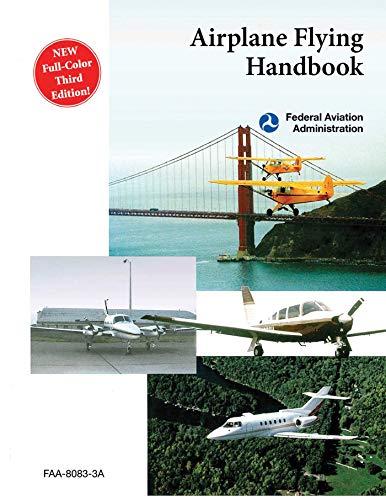-
Airplane Flying Handbook: FAA-H-8083-3A
Federal Aviation Administration
Paperback (Aviation Supplies & Academics, Inc., Sept. 1, 2004)The fundamental skills and essential information necessary for piloting airplanes are introduced in this beginning aviator's guide. Pilots wishing to improve their flying proficiency and aeronautical knowledge, flyers preparing for additional certificates or ratings, and flight instructors engaged in the instruction of both students and licensed pilots will benefit from the information in this pilot resource. The official FAA reference for the aviator-in-training, many test questions for the FAA Knowledge Exams for pilots come directly from this guide.
-
Airplane Flying Handbook
Federal Aviation Administration
eBook (Skyhorse, Sept. 11, 2011)The Federal Aviation Administration’s Airplane Flying Handbook provides pilots, student pi-lots, aviation instructors, and aviation specialists with information on every topic needed to qualify for and excel in the field of aviation. Topics covered include: ground operations, cockpit management, the four fundamentals of flying, integrated flight control, slow flights, stalls, spins, takeoff, ground reference maneuvers, night operations, and much more. The Airplane Flying Handbook is a great study guide for current pilots and for potential pilots who are interested in applying for their first license. It is also the perfect gift for any aircraft or aeronautical buff.
-
Airplane Flying Handbook
Federal Aviation Administration
Paperback (Skyhorse, Sept. 1, 2011)The Federal Aviation Administration’s Airplane Flying Handbook provides pilots, student pi-lots, aviation instructors, and aviation specialists with information on every topic needed to qualify for and excel in the field of aviation. Topics covered include: ground operations, cockpit management, the four fundamentals of flying, integrated flight control, slow flights, stalls, spins, takeoff, ground reference maneuvers, night operations, and much more. The Airplane Flying Handbook is a great study guide for current pilots and for potential pilots who are interested in applying for their first license. It is also the perfect gift for any aircraft or aeronautical buff. X
X
-
Airplane Flying Handbook FAA-H-8083-3A - Vol. 2
FEDERAL AVIATION ADMINISTRATION
MP3 CD (IDB Productions, Aug. 16, 2019)Airplane Flying Handbook FAA-H-8083-3A - Vol. 2 Introduction The overall purpose of primary and intermediate flight training, as outlined in this handbook, is the acquisition and honing of basic airmanship skills. [Figure 1-1] Airmanship is a broad term that includes a sound knowledge of and experience with the principles of flight, the knowledge, experience, and ability to operate an airplane with competence and precision both on the ground and in the air, and the application of sound judgment that results in optimal operational safety and efficiency. [Figure 1-2] Learning to fly an airplane has often been likened to learning to drive an automobile. This analogy is misleading. Since an airplane operates in a three-dimensional environment, it requires a depth of knowledge and type of motor skill development that is more sensitive to this situation, such as: • Coordination—the ability to use the hands and feet together subconsciously and in the proper relationship to produce desired results in the airplane. • Timing—the application of muscular coordination at the proper instant to make flight, and all maneuvers, a constant, smooth process. • Control touch—the ability to sense the action of the airplane and knowledge to determine its probable actions immediately regarding attitude and speed variations by sensing the varying pressures and resistance of the control surfaces transmitted through the flight controls. • Speed sense—the ability to sense and react to reasonable variations of airspeed.